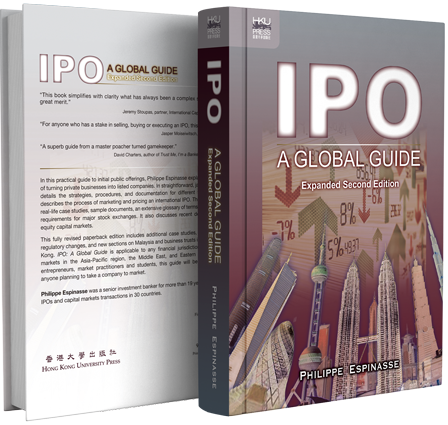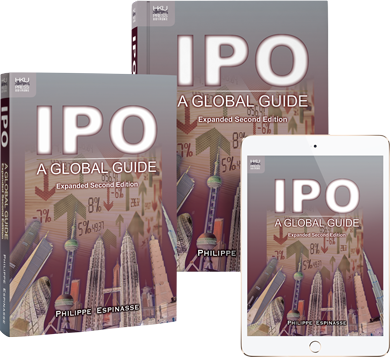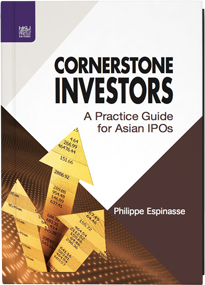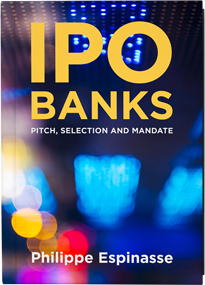
IPO:A Global Guide
The first-ever "how to" guide to executing global IPOs, applicable to any jurisdiction
Available in hardback, paperback, Kindle, and eBook editions
An up-to-date, practical guide to conducting an international IPO for issuers, entrepreneurs, market practitioners, students in business or finance – and anyone generally interested in IPOs and equity capital markets (ECM) transactions.
It covers all the individual steps throughout the issue process and is the only publication with a truly global outlook, and a focus on market practice and transactions across the Asia-Pacific region, the Middle East, Europe, and the Americas.
The book explains, in a straightforward, jargon-free style, the reasons why, and how, private businesses turn into listed companies; the strategies, procedures, and documentation; as well as the valuation, marketing, investor base, pricing, and allocation of an IPO. It also addresses post-IPO processes, including price stabilization, investor relations, as well as financing and other activities after listing.
The guide includes many recent, real-life case studies; an extensive glossary of more than 550 industry terms; a review of listing requirements for major stock exchanges around the world; and sample documents to support the explanations. It discusses all equity products, from straight equity to units in real estate investment trusts (REITs) and infrastructure funds to more recent ECM developments.
Guides issued by stock exchanges tend to focus primarily on listing criteria. Those published by legal advisers, consultants, and auditor firms usually only address that part of the issue process related to their particular area of expertise. They are often very technical in nature and generally do not include details of the marketing process or discuss institutional and retail investors.
Many publications on IPOs only focus on the theory of why companies go public, on corporate valuation (often using complex mathematical formulas), or consist of academic studies on anomalies associated with these transactions, especially how past IPOs have been over- or (more commonly) under-priced.
Other titles are also pretty much exclusively focused on the US or UK markets – and are often rather dated, whereas market practice for ECM offerings has evolved dramatically over the last five to 10 years.
I spent more than 19 years working, as a capital markets investment banker with major houses, on more than 140 IPOs and related transactions across some 30 countries. Drawing on this experience, I have produced an approachable guide intended to be applicable to any financial jurisdiction, and especially to emerging markets with vibrant IPO activity.
What’s in the Book?
1.1.1. Primary and secondary offerings
1.1.2. Other reasons for going public
1.1.3. Duties and drawbacks associated with listing
1.2.1. Listing requirements
1.2.2. The investment case
1.2.3. Strategic investors
1.2.4. Going public convertible bonds
1.2.5. Special purpose acquisition companies (SPACs)
1.2.6. Stand alone business and insider ownership
1.2.7. Liquidity and transaction size
1.3.1. Choosing the right listing location
1.3.2. Domicile and country of incorporation
1.3.3. Profile and prestige
1.3.4. Matching the profile of revenues
1.3.5. Index considerations
1.3.6. Valuation considerations
1.3.7. Initial and ongoing listing requirements
1.3.8. Targeting investor types
1.3.9. Research coverage
1.3.10. Dual and multiple listings
1.3.11. Tickers and codes
1.5.1. The banking side
1.5.2. The markets side
1.5.3. Other areas within the investment bank
1.5.4. Outside the investment bank
1.6.1. Entry level and beyond
1.6.2. The senior ranks
1.6.3. Head titles
1.7.1. Senior management
1.7.2. The core execution team
1.7.3. The ECM team
1.7.4. The equity syndicate desk
1.7.5. The in-house roadshow coordinators
1.7.6. The legal and compliance teams
1.7.7. The research analysts
1.7.8. The equity sales teams
1.7.9. Other areas
1.8.1. Deal sponsors
1.8.2. Global coordinators
1.8.3. Bookrunners
1.8.4. Lead managers
1.8.5. Junior syndicate members
1.8.6. Receiving banks
1.8.7. Independent advisers
1.8.8. Appearance
1.9.1. Key attributes of a lead bank
1.9.2. Requests for proposal
1.9.3. Oral presentations
1.11.1. Components of the gross fees
1.11.2. US market practice
1.11.3. Designations and split orders
1.11.4. Fee caps
1.11.5. Fees and re-allocation between tranches
1.11.6. Pre-agreed and guaranteed economics
1.11.7. IPO expenses
1.11.8. Trading fees
2.1. Legal advisers
2.1.2. Auditors
2.1.3. Property valuers
2.1.4. Specialist consultants and experts
2.1.5. Remuneration consultants
2.1.6. Roadshow consultants and financial PR firms
2.1.7. Designated market makers
2.1.8. Depositary banks
2.1.9. Financial printers
2.1.10. Translators
2.1.11. Share registrars and transfer agents
2.1.12. Receiving banks
2.1.13. Stock exchanges
2.1.14. Market research firms, advertising agencies and call centres
2.2.1. Independent and non-executive directors
2.2.2. Board committees
2.2.3. Directors responsibility and insurance arrangements
2.2.4. Local representatives
2.3.1. Availability of financial information
2.3.2. Due diligence, drafting and prospectus review
2.3.3. The marketing phase
2.3.4. Aftermarket activities
2.3.5. Other considerations on the timetable
2.3.6. Go and no-go decisions
2.3.7. Dual-track processes
2.4.1. Working groups and steering committee
2.4.2. Documentation
2.4.3. Valuation
2.4.4. Marketing
2.4.5. Publicity guidelines
2.4.6. Conference facilities
2.5.1. Questionnaires, verification notes and responsibility
2.5.2. Business and financial due diligence and site visits
2.5.3. Documentary due diligence
2.5.4. Syndicate and other due diligence
2.6.1. The F pages
2.6.2. Other financial information
2.6.3. The Management Discussion & Analysis (MD&A)
2.6.4. Segmentation of accounts
2.6.5. Profit forecasts
2.6.6. Financial disclosure in the US
2.7.1. The European prospectus directive
2.7.2. Additional disclosure for US investors
2.7.3. House formats or styles
2.7.4. Detailed contents
2.7.5. Domestic and international prospectuses
2.7.6. Preliminary and final prospectuses
2.7.7. Plain English and prospectus covers
2.8.1. Versions of the SAS 72 letter
2.8.2. Timing of delivery and negative assurance
2.8.3. Agreed-upon procedures letter
2.9.1. Legal opinions and due diligence reports according to jurisdictions
2.9.2. US legal opinions and disclosure letters
2.10.1. What is underwriting?
2.10.2. Hard underwriting
2.10.3. Soft or settlement underwriting
2.10.4. Retail tranches
2.11.1. Earnings multiples
2.11.2. Sales and cash-flow multiples
2.11.3. Growth multiples
2.11.4. Normalized multiples
2.11.5. Price-to-book or NAV ratios
2.11.6. Per pop valuations
2.11.7. Dividend and distribution yields
2.11.8. Discounted cash-flow valuations
2.11.9. Share price and number of shares
2.12.1. Sovereign wealth funds
2.12.2. Income and value investors
2.12.3. Index investors
2.12.4. GARP and growth investors
2.12.5. Specialty, quantitative investors and hedge funds
2.12.6. Contrarian investors
2.12.7. Cornerstone investors
2.12.8. Grading institutional investors according to quality
2.12.9. Bottom-up and top-down demand estimates
2.13.1. Fixed price offerings and advance payment
2.13.2. Methods of application
2.14.1. Institutional and retail tranches
2.14.2. Allocating and re-allocating between tranches
2.14.3. Accessing the US market
2.14.4. Accessing European investors and focus markets
2.14.5. Selling to Japanese investors
2.14.6. American depositary receipt and global depositary receipt tranches
2.15.1. Listing DRs
2.15.2. Global depositary receipts
2.15.3. American depositary receipts
2.15.3.1. Unsponsored ADRs
2.15.3.2. Sponsored ADRs
2.15.3.3. Rule 144A ADRs
2.16.1. The basic structure
2.16.2. Focused and diversified funds
2.16.3. Managing the fund
2.16.4. Financial engineering and growing the fund
2.17.1. The basic structure: Singapore vs. Hong Kong business trusts
3.1.1. Types of research analysts
3.1.2. Analyst rankings
3.1.3. Pre-deal research in IPOs
3.1.4. Why bother with pre-deal research?
3.2.1. Research guidelines & presentation to research analysts
3.2.2. Drafting pre-deal research
3.2.3. The blackout period
3.3.1. The rules of engagement
3.3.2. Advertising and legal names
3.3.3. Invitation telexes
3.4.1. How pre-marketing is performed
3.4.2. Pre-marketing other than by research analysts
3.4.3. Feedback forms
3.4.4. Setting the price range
3.4.5. Fixed price IPOs
3.5.1. Large scale presentations
3.5.2. Small group presentations
3.5.3. One-on-one meetings
3.5.4. Internet roadshows
3.6.1. Types of orders and book keeping
3.6.2. Manual demand forms
3.6.3. Designations and split orders
3.6.4. Demand curve
3.6.5. Managing the book
3.6.6. Adjusting the price range or the deal size
3.7.1. Concurrent offerings
3.7.2. Sequential offerings
3.7.3. Retail investor pools
3.7.4. Other types of retail offer
3.7.5. Retail incentiv
3.8.1. Objectives and scale
3.8.2. HR and performance consultants
3.8.3. Key considerations
3.8.4. A typical, three-tier ESOP
3.9.1. Deciphering the book of demand
3.9.2. Pitching the right price
3.9.3. What happens after pricing
3.10.1. Major clauses in a sale and purchase agreement
3.10.2. Force majeure clauses
3.10.3. Public offer underwriting
3.10.4. Inter-syndicate agreement
3.10.5. Agreements among managers
3.10.6. Receiving bank agreements
3.10.7. Delivery of legal opinions, comfort letters and other documents
3.11.1. Allocation criteria
3.11.2. Allocating a book of demand
3.11.3. Split orders
3.11.4. Free retention
3.11.5. Other considerations for institutional allocations
3.11.6. Placing letters
3.11.7. Retail allocations
3.11.8. Brokerage, transaction fees and levies
3.12.1. The settlement flow
3.12.2. Bring-down due diligence
3.12.3. The start of trading
3.12.4. The closing ceremony
4.1.1. The stabilizing agent and safe harbour exemptions
4.1.2. Over-allotment options
4.1.3. How a Greenshoe works in practice
4.1.4. Penalty bids
4.1.5. Naked shorts
4.1.6. Some controversial issues associated with stabilization
4.1.7. Other stabilization issues
4.2.1. The research blackout or “quiet” period
4.2.2. Issuer and shareholder lock-ups
4.2.3. Ongoing disclosure and listing requirements
4.2.4. Communicating with investors
4.2.5. Investor relations departments and their roles
4.3.1. Marketed offerings
4.3.2. Rights issues
4.3.3. Accelerated bookbuildings and block trades
4.3.4. Top-up placements
4.3.5. Convertible and exchangeable bonds
4.3.6. Private investments in public equity (PIPEs)
4.3.7. Preferred shares
4.3.8. Share buy-backs
4.4.1. It starts with a story
4.4.2. A strong management team
4.4.3. Size and liquidity
4.4.4. Picking the right time
4.4.5. Offering good value
4.4.6. Investor distribution
4.4.7. A successful aftermarket
Appendix 1: Case studies:
A NASDAQ IPO: Shanda Games
A NYSE IPO: Banco Santander Brasil
An LSE IPO: Essar Energy
A NYSE Euronext IPO: CFAO
A Hong Kong IPO: L’Occitane
A Singapore IPO: CapitaMalls Asia
A Bursa Malaysia and Singapore IPO: IHH Healthcare (expanded, second edition only)
Appendix 2: Business and financial due diligence check list
Appendix 3: Table of estimates for IPO fees and expenses
Appendix 4: Sample contents for an international IPO prospectus
Appendix 5: Sample risk factors for an international IPO
Appendix 6: Example of feedback form for investor education
Appendix 7: Example of manual order form for bookbuilding
Appendix 8: Initial listing requirements for major stock exchanges:
Listing in New York on Nasdaq
Listing in New York on the NYSE
Listing in London on the LSE
Listing in Paris, Amsterdam, Brussels, Lisbon or London on NYSE Euronext
Listing in Frankfurt on Deutsche Börse®
Listing in Zürich on the SIX
Listing in Dubai on Nasdaq Dubai
Listing in Hong Kong on HKEx
Listing in Singapore on the SGX
Listing in Kuala Lumpur on Bursa Malaysia (second edition only)
Listing in Tokyo on the TSE
Listing in Sydney on the ASX
Introduction Excerpt
This book looks beyond the theory and is intended as a guide to conducting international IPOs for entrepreneurs, corporate management teams, private equity and venture capitalists, market practitioners, and students in finance.
Endorsements
Philippe Espinasse is Mr IPO. There is no greater authority on the Asian new listings market”
Jasper MoiseiwitschSouth China Morning Post
A comprehensive yet easily approachable guide that unmasks the inner workings of an IPO by an experienced investment banker. The book will be of great value to companies planning for an IPO, as well as to finance professionals and to candidates who would like to get into the finance industry”
Paul W. LaiFormer Head of Greater China Investment Banking, CLSA Equity Capital Markets
In recent years, China has emerged as one the largest IPO markets around the globe. However, most publications on the subject only look at listing rules or valuations issues; few address the practicalities associated with floating a company and, if so, most attention is devoted to Western markets rather than to Asia. Given his wealth of experience in the Asian IPO markets, Philippe is in a unique position to provide insight into the step-wise process of a successful listing in the region. This should be interesting reading for all Chinese companies looking to raise capital in the international equity capital markets”
Herald van der LindeManaging Director & Deputy Head of Equity Research, HSBC
A sophisticated and detailed study that takes a major step forward in IPO research and analysis. It covers not just a topic but a whole territory. The new benchmark for all subsequent inquiries on the subject”
Takashi Kasagami & Charles VacherPacific Financial Partners, LLC
Philippe has done a great job of capturing the essentials of IPOs in a logical and easy-to-read manner. This is a must-read for finance professionals and entrepreneurs who would like to gain an understanding of IPOs via a step-by-step approach, and through a practitioner’s insight”
Cecilia FongManaging Director, Mergers & Acquisitions, Somerley Limited
About time. A well-written book for the user; clearly navigating the critical decisions faced by issuers in this otherwise opaque market”
Julian ProctorManaging Director, Tiger Group Investments
The only comprehensive volume about IPOs, it is actually three books into one: a practical guide for the entrepreneur assessing a listing for his company; an insightful research for the investor facing new global opportunities; and a must read for every professional and student willing to better understand the changing world of IPOs through an insider’s eyes”
Didier LamarcheFounder and Chief Executive Officer, Adam Smith Capital
Philippe has put together an impressively comprehensive compendium of all aspects of getting an IPO done. The book has revealed all the trade secrets and will serve as a useful introduction to novice, and guide to all, practitioners”
George Kwok Lung Hongchoyxecutive Director & Chief Executive Officer, The Link Management Limited
Insight from a practitioner who has seen the IPO market mature and become truly global during his almost 20 years in the business. Espinasse writes with authority on one of the most high-profile but little understood sectors of the financial markets. The book is particularly valuable for being written by a professional in Asia, now that IPOs from that part of the world are leading the way in volume and in innovation”
Julian WaldronChief Financial Officer, Technip
A complete approach to what an IPO exercise is all about, written by one of the most experienced professionals in the banking industry”
Jorge CalvetChairman & Chief Executive Officer, Gamesa Corporación Tecnológica
I only wish that this guide had been available in the 1980s and 1990s, when the great international IPO boom took off. It is packed with the information that any practitioner – or would-be practitioner – needs to navigate their way through the cross-cutting complexities of getting an IPO up and running, right round the world. Espinasse never lets us forget that there is a great deal of art involved in an IPO and judgement is a vital component of the event. This brilliant guide is an invaluable support”
Lord FreudAuthor of "Freud in the City", Former Vice Chairman, UBS Investment Bank, UK Minister for Welfare Reform
For any professional involved directly or indirectly in equity capital markets, ‘IPO: A Global Guide’ is an excellent and detailed overview of the major IPO markets and issues around the world. Philippe has managed to summarize in an easy to read format some very technical information, making it a must-own publication for industry professionals at all levels. For anyone entering the IPO business, this will also guide the reader to quickly compare, contrast and create check lists for a variety of markets. I highly recommend this book for investment bankers, capital markets professionals, legal and compliance and other industry professionals to source information on the exciting global IPO industry”
Marshall NicholsonGlobal Head of Equity Capital Markets & Vice Chairman of the Investment Banking Division, Bank of China International
Philippe Espinasse’s book is a true encyclopaedia and also a remarkable reference publication on IPOs. It includes everything one needs to know about the strategy and conduct of an international IPO to achieve a successful offering in today’s market. His approach is very pragmatic rather than theoretical or academic – he goes straight to the point on both major strategic decisions and more execution-related issues”
Jacques-Henri DavidFormer Chief Executive Officer of Deutsche Bank in France & Chairman, Acxior Corporate Finance
As an experienced practitioner of the ‘dark arts’ of equity capital markets, Philippe brings a wealth of knowledge to the study of this process that even market participants will find interesting, and neophytes will find fascinating and enriching”
Piers Higson SmithFormer Director, Head of Capital Markets, Platinum Securities
A most enjoyable and well-informed insider’s guide that looks beyond the theory and examines in detail all aspects of conducting an international IPO. A very valuable read for issuers and other participants in the global equity markets”
Datuk Ganen SarvananthanFormer Executive Director & Head of Investments, Khazanah Nasional Bhd
Philippe Espinasse lays out a comprehensive, detailed, step-by-step approach for everyone from college graduates to CEOs to become familiar with IPOs”
Anthony PowerChief Investment Officer, Emirates Investment & Development P.S.C.
Highly recommended! Espinasse has written a superb, concise and comprehensive guide for practitioners and novices alike. Entrepreneurs who are considering the public route as well as private equity GPs looking to exit through the IPO markets will undoubtedly find this an invaluable resource”
Doris NgManaging Director - Business Development, AIF Capital
Philippe’s well researched book is a valuable initiative. Coming from someone with direct experience of IPOs, it is also wholly objective and complete. A most positive and productive contribution”
François de Carbonnelormer Chairman of the Board, Thomson S.A. & Director of Amgen Inc., Quilvest S.A., and Solocal Group
Philippe’s global guide on IPOs is a must-have – and must-read – in today’s market of scarce and expensive capital. His global and vast experience of taking companies public from a wide range of sectors, and with varied strategic rationales, makes this a unique and truly ‘one stop shop’ reference book for entrepreneurs and CFOs”
Juan Muro-LaraHead of Corporate Development, Acciona, S.A.
A treasure trove of information for family-owned groups; full of practical advice on the rocky road to a public flotation”
Maxime HolderChairman, Groupe Paul





















